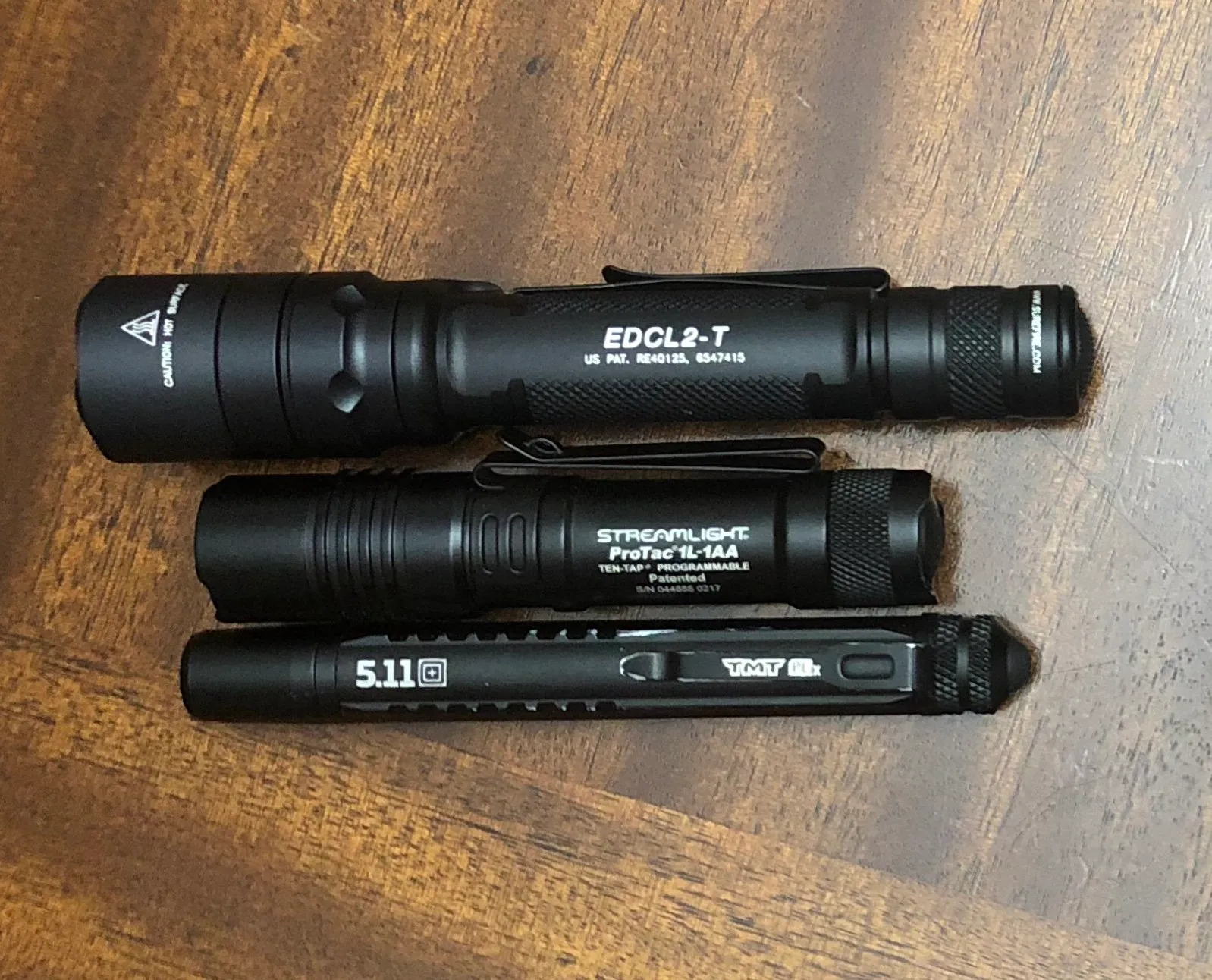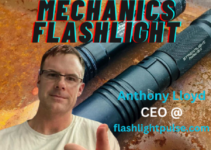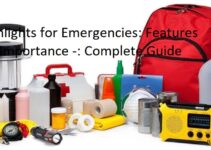Are you worried about navigating in the dark? A reliable Everyday Carry (EDC) flashlight could be your perfect solution!
You’ll find a complete guide detailing the benefits of using an EDC flashlight and what to look for when making your purchase. Keep reading to find out more.
Carrying a small flashlight on your person each day, also known as an Everyday Carry (EDC) flashlight, is becoming increasingly popular. Whether you need a light for your job, for camping and general outdoor activities, or just to carry around with you day-to-day in case of emergencies, there are various benefits to having an EDC flashlight. To help you choose the perfect EDC flashlight, we’ve assembled this comprehensive guide designed to give you all the information you need to make an informed decision.
In this guide we will discuss:
- The different types of EDC flashlights available
- How each type connects to applications and situations
- The features and specifications of each type
- The pros and cons of an EDC flashlight
- Different battery types for EDC flashlights
- Additional accessories that can be used with an EDC flashlight

Explanation of the concept of Everyday Carry (EDC)
Everyday Carry (EDC) is the practice of carrying essential items with you on a daily basis, so that you are always prepared for whatever situations or events life may have in store. These items typically include things such as a wallet, cellphone, multi-tool, flashlight and watch. In addition to these everyday carry pieces, individuals’ EDC contents can change based on the environment and the activities they will be engaging in.
Unlike a disaster preparedness kit that focuses solely on surviving an emergency situation, EDC gear is about being ready for anything from fixing a flat tire or purchasing groceries to performing basic maintenance around your house or deterring attackers. Ultimately, by carrying an EDC collection of gear and gadgets close at hand up all day every day, you will be able to keep your mind free from worrying about what may happen when you find yourself out of luck and in need of a tool or everyday item.
This is why the utilization of an Everyday Carry Flashlight should not be overlooked – more often than not it might just save the day!
Explanation of the importance of a flashlight in EDC
Having a flashlight in your Everyday Carry (EDC) is a necessity that many people underestimate. Flashlights provide life-saving illumination while also providing other important uses. EDC flashlights are great for reading in the dark, finding your way around unfamiliar places, and even signaling for help in a pinch. Furthermore, they can be used to alert people to your presence and location, such as when you’re out of cell range on a backpacking trip and have lost your way. Flashlights are compact and lightweight, making them easy to carry with you on a daily basis even if you don’t think you need one.
Flashlights provide numerous practical benefits like helping you see during power outages or when camping at night. They can help identify potential hazards that may lurk in the dark and allow for better navigation of an unfamiliar area. Rechargeable flashlights come with extremely useful features like adjustable brightness settings, SOS signals flashes, red & infrared light outputs and various color outputs like blue & violet light outputs among many others; these features enable users more versatility to deal with various situations they may find themselves in. Additionally, headed flashlights are becoming more widespread every day and provide superior lighting compared to regular EDC flashlights with their improved lumens output which gives lesser weight but improved visibility depending on usage situations. All of these functions can be crucial when lost or injured outdoors or other similar scenarios; having an EDC flashlight that fits easily into your pocket or backpack could mean the difference between life or death under those circumstances.
Purpose of the guide
This guide is meant to provide you with information on the practical use of an Everyday Carry (EDC) flashlight and the benefits they offer. In it, we will discuss how an EDC flashlight can be used in a variety of different circumstances and why they are popular among everyday-carry enthusiasts.
We will also explain why an EDC flashlight should always be part of your everyday carry kit and what to look for when selecting one. Lastly, this guide will offer helpful advice on the use, maintenance, and storage of your EDC flashlight so that it stays in top condition for years to come.
Choosing the Right EDC Flashlight

Choosing the right EDC flashlight can be a daunting task, with all the different types and options that are available on the market today. Here are some things to consider when making your decision:
Size – Generally, EDC flashlights come in a variety of sizes, so you’ll want to consider which size would be most convenient for you to carry. If you’re only going to be using it occasionally then a smaller, more compact size is fine; however, if you believe you’ll be using it often then you may want an option with more features and thus requiring a larger size.
Functionality – Think about what your needs are and what type of functionality makes sense for your given situation. There are models designed for tactical use which will feature strobe functions or adjustable beam patterns, whereas others feature multiple brightness settings or modes that allow you to customize your experience further.
Battery Life – The battery life of your EDC flashlight is another important factor to consider as this determines how long the light will stay lit before needing recharging or replacing of batteries. The average lifespan is around 100-200 lumens (the unit measuring perceived brightness), but longer life can be found in higher powered models. For those who plan on using their EDC flashlight often and require bright lighting at extended periods of time, look for lithium rechargeable batteries as they tend to provide greater power over all other battery types.
Durability – Look for LED flashlights made with high quality materials such as aluminum alloy bodies that offer durability and extended performance life-span in order to last through weather conditions or damage from accidental falls onto hard surfaces or water submersion. In addition, look for unbreakable buttons whose rubber seals render them waterproof even when submerged in several feet of water can improve safety while out outdoors or at home during emergencies like power outages due to bad weather conditions or fires.
Factors to consider when choosing an EDC flashlight

When selecting an EDC flashlight, there are several factors to consider in order to ensure you make the right purchase. The size and weight of the light must be taken into account, as well as how easy it is to operate and the runtime. Knowing which beam pattern is most suitable for your intended purpose will also be important.
Size/Weight – An EDC flashlight needs to be small enough to carry around on a regular basis, yet still powerful enough for its intended purpose. Many EDC flashlights range from 2-16 ounces, with the average weight being under 6 ounces. Practical size limitations need to be based on what you’re willing to carry versus finding a light that offers the features you need.
Operation – Ease of use must also be taken into account when choosing an EDC flashlight; after all, who wants something that takes too long to operate simply due to its design? Most high-quality clop lights feature two or three buttons, providing fast access to brightness levels and light modes in a few simple clicks.
Runtime – Medium and higher end EDC flashlights offer poor battery life if they are not properly regulated (constant brightness level maintained over time). In this instance make sure that your EDC flashlight has some form of battery level indication so that you can anticipate when it needs recharging or inserting fresh batteries.
Beam Patterns – Every user may have different preferred beam patterns such as a strong hot central spot or flood pattern for area lighting with minimal throw—or something else entirely different such as flood-to-spot combination with amber filters etc (depending whether it’s work or outdoor use). LED technology has developed rapidly over recent years; before making any purchase research beam outputs available on particular models and decide what type fits best for your every day circumstances.
Size and weight
When you’re deciding on a flashlight to include in your EDC, size and weight are important factors to consider. A heavy or bulky flashlight can be a burden, distracting from the many benefits of an EDC kit. You’ll want to get something that is lightweight and portable, yet powerful enough for any situation.
Not all flashlights are created equal, but there are some general guidelines for size and weight that can help you decide which model is the best for your EDC:
– The length of most EDC flashlights will range from 3-5 inches long; this is small enough to easily fit into most pockets or attach to a keychain without being uncomfortable.
– The weight should be approximately 1 ounce or less; this will keep it light enough to carry around all day without weighing down your pockets.
– Look for impact and water resistance ratings if available; these features will ensure the durability of your device should it be dropped or exposed to moisture.
Brightness and modes

When it comes to selecting an Everyday Carry (EDC) flashlight, the brightness and light modes are essential features to consider in order to make sure you’re picking the best possible option for your needs. EDC flashlights usually have several lighting modes, including low, medium, high and even some special light settings such as a Strobe or SOS functions. You may also come across a mode called Ultra Low which lets you dim the output of the light.
Brightness is expressed in lumens; a measure of emitted visible radiation per season per unit area over all steradians. This translates into how much total visible light will be emitted from your flashlight at its peak power when on its highest setting – that is why it is important to read customer reviews and product specifications carefully when choosing an EDC flashlight; the brighter, the better! With most EDC flashlights capable of providing from 50 up to 1000 lumens, it may help to consider what tasks will be required and match that with lumen/mode capability.
Battery and runtime
Battery type and runtime are important factors to consider when selecting an EDC flashlight. Lithium-ion (Li-ion) batteries are commonly used in EDC flashlights since they provide excellent performance, extended runtimes and rechargeable capabilities. Some EDC flashlights use single-use, disposable batteries such as alkaline, but these generally do not offer the same level of performance as Li-ion batteries and are heavier.
Other key features to look for include momentary activation, advanced user interfaces (e.g. alternate lighting modes) and water resistance ratings — all of which impact the overall usability and durability of your flashlight. As a rule of thumb, you should aim for an EDC flashlight that has a runtime that is appropriate for your intended application (e.g., 30 minutes is fine for general use but may not be suitable for professional search operations). Additionally, ensure that your flashlight has sufficient weather sealing to withstand inclement weather when carrying it outdoors.
Durability and water resistance
When purchasing an EDC flashlight, it is important to ensure that it is made from materials that will last and resist breaking or becoming damaged under intense pressure. In most cases, you will almost certainly require a flashlight made from lightweight yet durable materials such as aircraft-grade aluminum or titanium.
Additionally, you should look for a model with o-ring seals to keep out dust and debris, as well as waterproofing ratings of IPX7 or higher to protect against water damage in inclement weather. This can be particularly useful for any potential camping trips or hikes through wet climates.
Whatever EDC flashlight you choose, make sure it can withstand everyday wear and tear before making your investment.
User interface and ease of use
EDC flashlights usually have a user-friendly interface featuring physical buttons and dials, as well as light-sensitive switches that power the device on and off in certain conditions. Select models of flashlights are also equipped with more advanced user interfaces, including rotary knobs and sophisticated digital screens that offer more control over brightness and other settings. All of these components can be easily manipulated when needed to operate the product in different emergency situations or darkness levels.
Most EDC flashlights have a tail cap switch that is easy to activate with one hand, allowing you to quickly access your device in emergency situations or when using it for everyday tasks like reading or hunting. The switch is usually textured so you can operate it reliably even when wearing gloves or if your hands are cold and damp. Additionally, some models may include multiple light output levels that enable you to adjust brightness depending on your needs. Finally, some products feature reversible clips or self-locking latch systems that make it easy for you to attach the flashlight securely to clothing or store it in your pocket without worrying about accidental activation.
Popular EDC flashlight brands and models
EDC flashlights come in a variety of shapes and sizes to suit every need. There are many popular brands on the market today, such as Olight, Fenix, Nitecore, Foursevens, and Surefire. One question you may ask yourself is “which model should I buy?” This can be daunting with so many options available. Generally speaking, you get what you pay for in terms of brightness, battery life and build quality. A good place to start is to compare specs like run time (battery life), lumens (measurement of brightness) head size and includes extras like strobes or multiple outputs. Here are some popular models to consider:
-Olight S2R Baton II: The flagship EDC flashlight from the renowned Taiwan based brand is a powerful 1150 lumen output that can last up to 1 hour on its highest setting with an 18650 battery powered by magnetic charging technology for quick recharging.
-Fenix PD35 V2.0: Offering 1000 lumens on its brightest setting powered by a rechargeable 18650 or 2 CR123A batteries this light packs plenty of power without breaking the bank.
-Nitecore Tube UL: This tiny keyring sized light weighs less than an ounce yet offers 45 lumens from a AAA battery and utilizes reverse polarity protection for added safety.
-Foursevens Mini ML LED Flashlight: This light has been around for over a decade but still proves itself as one of the most reliable lights on the market thanks to its water resistant aluminum body and powerful Cree LED that offers 455 lumens on turbo mode made possible by its supported 14500 rechargeable li-ion battery.
-Surefire Sidekick Rechargeable Flashlight: A sleek pocket sized flashlight that provides 300 lumens brightened by its high performance LED with an internal USB rechargeable lithium-ion battery that lasts up to 90 minutes on medium setting and comes equipped with exceptional defense settings like low sensory output strobe mode and high/medium/low settings which makes this one of favorite picks among professionals world wide.
Conclusion
In conclusion, having an EDC flashlight is an essential tool that can be carried on a daily basis. It offers a variety of benefits and applications across numerous different situations and activities. Its portability and versatility make it an invaluable tool to own; combined with the wide range of sizes, designs and illumination capabilities available, it is easy for anyone to find the perfect solution for their needs.
These features are just the top of the iceberg when it comes to adding an EDC flashlight to your everyday carry kit. With continued technological advancements in this market, more practical benefits will emerge; you’ll always have something reliable and necessary in times of emergencies or inconvenience. So pick up your favorite model today!
FAQs
Should I carry a flashlight everyday?
It’s a personal choice, but it can be helpful in certain situations.
What is the importance of carrying a flashlight?
Carrying a flashlight can provide light in dark situations, increase safety, and help you find items in low-light conditions.
What is a EDC flashlight?
EDC stands for “Everyday Carry,” so an EDC flashlight is a small flashlight that you can easily carry with you every day.
Can a flashlight save your life?
In some situations, such as signaling for help or disorienting an attacker, a flashlight may potentially help save your life.
Why flashlight is good for self defense?
A flashlight can be used to temporarily blind an attacker or to strike them as a makeshift weapon, making it a potentially useful tool for self defense.
Are flashlights good for self defense?
While a flashlight is not a replacement for self defense training or a weapon, it can be a helpful tool in certain situations.
Is a flashlight good for EDC?
Yes, a small flashlight is a useful tool to have as part of your everyday carry items.
Is A flashlight good for your eyes?
Using a flashlight properly and responsibly is unlikely to cause harm to your eyes.
Should you carry with a flashlight?
It’s ultimately up to your personal preference and situation, but carrying a flashlight can provide extra safety and peace of mind.
Should I use a flashlight when walking at night?
Yes, using a flashlight when walking at night can increase visibility and safety, making it a good idea to carry one.
See More
- Best pen flashlight 2023
- Best pencil flashlight 2023
- Best pocket flashlight 2023
- Best stun gun flashlight 2023
- Best tactical flashlight 2023


